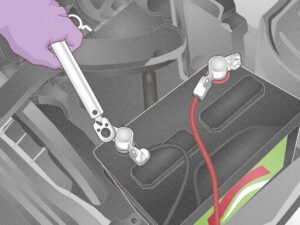Battery reconditioning is a term that often pops up when discussing battery chargers, but what exactly does it mean? Put simply, battery recond is a feature found on certain chargers that can revitalize old or deeply discharged batteries, extending their lifespan and saving you money. If you’ve ever wondered how to bring your seemingly dead batteries back to life, then read on. In this article, we’ll dive into the world of battery reconditioning and explore its benefits, limitations, and how it can help you get the most out of your batteries. So, what does battery recond mean on a battery charger? Let’s find out.
What Does Battery Recond Mean on a Battery Charger?
Have you ever come across the term “battery recond” on a battery charger and wondered what it means? Battery recond, short for battery reconditioning, is a feature found on some modern battery chargers that offers a unique way to revive and extend the life of certain types of batteries. In this article, we will explore in detail what battery recond means, how it works, and its benefits. So, let’s dive in and unlock the mysteries of battery recond!
Understanding Battery Reconditioning
Battery reconditioning, as the name suggests, is a process that aims to restore the capacity and overall performance of a battery that has experienced a decline in performance over time. It is particularly useful for rechargeable batteries, such as lead-acid batteries commonly found in cars and other vehicles, as well as certain types of lithium-ion batteries.
Rechargeable batteries tend to lose their capacity and efficiency over time due to factors like sulfation, a build-up of lead sulfate crystals on the battery plates, or the formation of memory effects in some types of batteries. Battery reconditioning helps to address these issues and revive the battery’s performance, essentially breathing new life into it.
How Does Battery Reconditioning Work?
Battery reconditioning typically involves a series of charging and discharging cycles, along with the application of controlled voltage and current to remove the build-up of sulfation or break down memory effects. The precise methods vary depending on the type of battery and the charger’s design.
Modern battery chargers with a reconditioning feature use advanced algorithms and intelligent charging profiles to optimize the reconditioning process. These chargers analyze the battery’s condition, monitor its voltage and current levels, and determine the appropriate charging and discharging parameters to effectively recondition the battery.
During the reconditioning process, the charger will charge the battery at specific voltage levels, followed by discharging it to a certain level. This cycle is repeated several times, with each cycle slowly breaking down the sulfation or memory effects and improving the battery’s overall performance.
Benefits of Battery Reconditioning
Now that we understand what battery recond means and how it works, let’s take a closer look at the benefits it offers:
1. Extended Battery Life: Battery reconditioning can help extend the lifespan of rechargeable batteries, allowing you to get more use out of them before needing a replacement. This can save you money in the long run and reduce unnecessary waste.
2. Improved Performance: By removing sulfation or memory effects, battery reconditioning can significantly improve the battery’s performance. This means longer runtimes, faster charging times, and better overall reliability.
3. Environmental Friendliness: Reconditioning batteries can contribute to a more sustainable approach to battery usage. By revitalizing old batteries instead of disposing of them, you reduce the environmental impact associated with battery waste.
4. Cost Savings: Instead of purchasing new batteries, battery reconditioning allows you to revive and restore the performance of your existing batteries. This can result in substantial cost savings, especially for batteries with a high replacement cost.
5. Versatility: Battery reconditioning is not limited to a specific type of battery. Depending on the charger’s capabilities, it can be used for various rechargeable batteries, including lead-acid, lithium-ion, nickel-cadmium, and more.
How to Utilize Battery Reconditioning
To make the most of the battery reconditioning feature on your charger, follow these steps:
1. Ensure the Compatibility: Check whether the battery reconditioning feature is available and compatible with the type and size of battery you intend to recondition.
2. Connect the Charger: Connect the charger to the battery, ensuring the positive and negative terminals are correctly aligned.
3. Set the Charger Mode: Select the appropriate charging mode on your charger that includes the reconditioning feature. Some chargers have a specific recond mode, while others may incorporate reconditioning within their standard charging modes.
4. Initiate the Process: Start the reconditioning process by following the charger’s instructions. Typically, the charger will automatically analyze the battery’s condition and apply the necessary charging and discharging cycles.
5. Monitor the Progress: It is essential to monitor the charger’s progress during the reconditioning process. Observe the voltage and current levels, charge times, and any alerts or notifications provided by the charger.
6. Complete the Process: Once the reconditioning process is complete, the charger will automatically switch to a maintenance or float charge mode to keep the battery in optimal condition.
Battery reconditioning, or battery recond, is a valuable feature found in modern battery chargers that can revive and extend the life of rechargeable batteries. By understanding the concept, benefits, and how to utilize battery reconditioning, you can effectively improve the performance and longevity of your batteries. Embracing this technology not only saves you money but also promotes a sustainable and environmentally friendly approach to battery usage. So, unlock the full potential of your batteries with battery reconditioning and enjoy longer-lasting, more reliable power!
Battery recondition: success this time
Frequently Asked Questions
What does battery reconditioning mean on a battery charger?
Battery reconditioning refers to a feature available on certain battery chargers that attempts to restore the capacity and performance of a worn-out or weak battery. It involves a specialized charging process that can help revive batteries that have lost their ability to hold a charge effectively.
How does battery reconditioning work on a battery charger?
Battery reconditioning typically involves a series of charging cycles that aim to break down sulfation, a common issue in lead-acid batteries. Sulfation occurs when lead sulfate builds up on the battery plates, reducing their ability to hold a charge. The reconditioning process applies controlled charging and discharging cycles to help remove this buildup and potentially restore the battery’s capacity.
Can battery reconditioning extend the lifespan of a battery?
Battery reconditioning has the potential to extend the lifespan of a battery by addressing certain issues that can lead to reduced performance. However, it’s important to note that not all batteries can be successfully reconditioned, especially if they have suffered severe damage or if the underlying problem lies beyond the effects of sulfation.
When should I use the battery reconditioning feature on a battery charger?
You should consider using the battery reconditioning feature on a charger when you notice a significant reduction in the battery’s performance, such as reduced runtime or difficulty holding a charge. This feature is particularly useful for lead-acid batteries, such as those used in vehicles or backup power systems, as they are prone to sulfation over time.
Is battery reconditioning safe to use on all types of batteries?
Battery reconditioning is primarily designed for lead-acid batteries, including flooded, AGM, and gel types commonly found in vehicles and other applications. It is not recommended to use battery reconditioning features on lithium-ion or other types of rechargeable batteries, as they require different charging protocols and may pose safety risks if mishandled.
Final Thoughts
Battery recond, short for battery reconditioning, is a feature found on certain battery chargers. This function is designed to revive and improve the performance of old or weak batteries. When you use the battery recond feature on a charger, it applies a specialized charging algorithm that helps break down sulfation, a common cause of battery failure. By effectively reversing the sulfation process, battery recond can potentially extend the lifespan and restore the capacity of the battery. So, if you’re wondering what does battery recond mean on a battery charger, it refers to the process of revitalizing batteries to enhance their performance and longevity.



